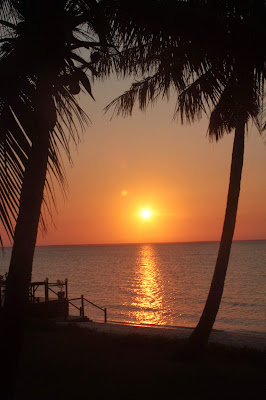 |
| Blue Zebra's view, sigh... |
So glorious the views from Blue Zebra Island Lodge, so delicious the
island vibe, so cold the Carlsberg beer - it was only after about an hour that
it occurred to me that you don’t get blue zebras. Excuse me?
Turns out the blue zebra is a kind of cichlid, that’s a fish, endemic to
Lake Malawi – and one of the many hundreds of thousands of pretty, patterned reasons
this lake is a UNESCO world heritage site. About 875 species of cichlids occur
in Lake Malawi, giving it the biggest assembly of fish species of any lake on
earth and making it an “outstanding example of biological evolution”.
 |
| Marelli archipelago mmmmmm |
That sounded like a fantastic reason to celebrate – so we headed out on
a sunset cruise. The sunsets are wild here, red and riotous; the atmosphere
ancient. We saw ducks flying in formation, fishermen in dugout canoes returning
home from a day on the water, the twinkle of lights on the mainland. Blue Zebra
is in the southern part of the lake, where most of the tourism happens, but it’s
far from the crowds, tucked away on Nankoma Island, the only inhabited island
in the Marelli archipelago. And by inhabited they mean a few luxury chalets, a restaurant,
bar and an infinity pool.
Birdsong fills the island at dawn. There 350 species here – the birds flourish
because there are no nest-robbing, egg-eating monkeys on the island – and all
day you hear the cry of the African fish eagle, Lake Malawi being home to a high concentration of them.We headed out
on a morning walk – you can get around the island in a few hours – and saw patches
of forest, enormous baobabs, lake views and wild flowers. Being an island of
course, this is water activity central. You can do snorkelling, scuba diving,
wake boarding, swimming. And because the channels are too deep, there are no
hippos or crocs out here.
There are however, hundreds of hippos and crocs further south on the
Shire River, the only outlet for Lake Malawi and part of Liwonde National Park.
A small – 580 km sq – Liwonde is drop
dead gorgeous, with mountains in the background, water in the foreground and
banks of creamy clouds.
The Shire River flows along the western border of Liwonde National Park,
so a boat safari is the way to go here. It took about an hour or so to get to
Wilderness Safari’s Mvuu Lodge, which is an elegant private concession in the
park. Fever trees and palm trees, peeking hippos, chilled elephants - in the
sense of behaviour, not temperature, although you never know what you may get
with your cocktail at a Wilderness lodge.
 |
| Egrets, I have a few, but then again... |
Tucked into the bush on the river’s edge, each of the chalets have river
views and close-ups of crocodiles. I counted five one morning from my verandah,
including a real giant gherkin of a monster, whose footprints we saw later
quite some distance away, on the banks. We did a morning walk through the bush,
through a patch of mopaneveld, and saw python vines, rutting impalas, frisky
zebras and amorous baboons. We ended up with a classic riverbank bush breakfast,
drinking coffee and listening to weavers and fish eagles.
 |
| The Shire River, Great African Rift Valley prrrrrrr |
Later that afternoon we were right at the top of the Satemwa tea estate,
G&T in hands, looking down on the Shire River and the Great Rift Valley.
What a view. Satemwa is one of Malawi’s oldest and most established tea estate– it was started in 1923 – and the tea
covers slope upon slope right up into the misty hills, where the vegetation changes
to montane forests and the evenings are chilly.
“Isn’t this the most romantic view?” said my friend the happily-married
Sally. “I wish I was in love with you”.


















